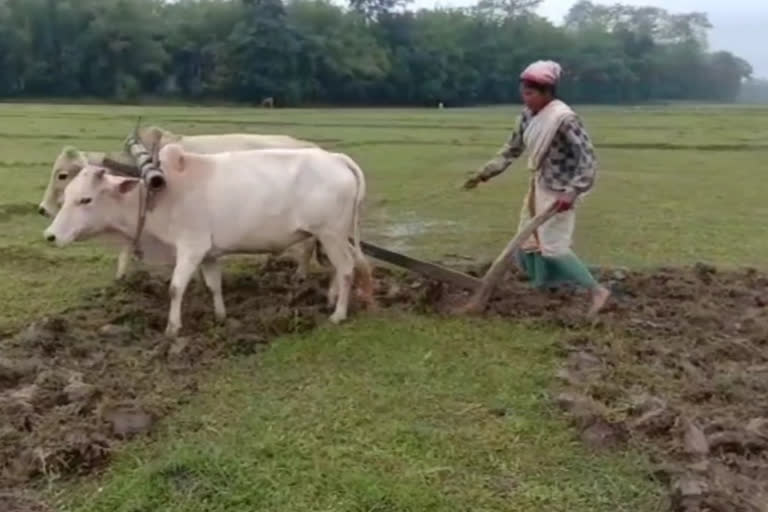New Delhi: On August 9, 2020, the Prime Minister launched the Rs 1 lakh crore Agriculture Infrastructure Fund (AIF) to build post-harvest storage and processing facilities, largely anchored at the Farmer Producer Organisations (FPOs). The fund will also be used to provide loans, at concessional rates, to FPOs and other entrepreneurs through primary agriculture credit societies (PACs). NABARD will steer this initiative in association with the Ministry of Agriculture and Farmers Welfare.
The Centre will bear this expenditure by providing interest subvention of 3 per cent on term loans for post-harvest management. The Centre will also provide a guarantee to banks for loans up to ₹2 crore for possible defaults by borrowers. This will be done through Credit Guarantee Fund Trust for Micro and Small Enterprises for loans up to ₹2 crore. The Government will pay the fee for this guarantee.
The main objective of the AIF is to attract investment in post-harvest infrastructure which has been a weak link in the agricultural supply chain. Thus, warehouses, silos, pack houses, sorting and grading units, cold chain projects, ripening chambers, e-marketing platforms, etc will be eligible for interest subvention of 3 per cent.
The fund is a major step towards getting agri-markets right. The central government had earlier issued three ordinances related to the legal framework of agri-markets with a view to bringing about some degree of liberalisation. These ordinances relate to amendments in the Essential Commodities Act, allowing farmers to sell their produce outside the APMC mandis and encouraging farming contracts between farmers, processors, exporters and retailers. Changes in the legal framework are a necessary condition, though not a sufficient one, for getting agri-markets right. Creating post-harvest physical infrastructure is as important as the changes in the legal framework. The AIF will help fill this gap. Its positive impact will be evident in due course, depending upon how fast, and how earnestly, the states, FPOs, and individual entrepreneurs implement the reforms initiated by the Centre.
Also read:SC grants 10 years to telecos to pay AGR-related dues
Since NABARD is also responsible for the creation of 10,000 more FPOs, it should create a package that could help these outfits realise better prices. Here are a few missing elements of the puzzle. There is no doubt that more and better storage facilities can help farmers avoid distress selling immediately after the harvest when prices are generally at their lowest. But small farmers cannot hold stocks for long as they have urgent cash needs to meet family expenditures.
The value of the storage facilities at the FPO level could be enhanced by a negotiable warehouse receipt system: FPOs can give an advance to farmers, say 75-80 per cent of the value of their produce at the current market price. But FPOs will need large working capital to give advances to farmers against their produce as collateral. Unless NABARD ensures that FPOs get their working capital at interest rates of 4 to 7 per cent — like farmers get for crop loans — the mere creation of storage facilities will not be enough to benefit farmers. Currently, most FPOs get a large chunk of their loans for working capital from microfinance institutions at rates ranging from 18-22 per cent per annum. At such rates, stocking is not economically viable unless the off-season prices are substantially higher than the prices at harvest time.
NABARD should devise a compulsory module that trains FPOs to use the negotiable warehouse receipt system and navigate the realm of agri-futures to hedge their market risks.
Second, government agencies dabbling in commodity markets, the Food Corporation of India (FCI), National Agricultural Cooperative Marketing Federation of India (NAFED), State Trading Corporation (STC) should increase their participation in agri-futures. That is how China deepened its agri-futures markets.
Third, the banks that give loans to FPOs and traders should also participate in commodity futures as “re-insurers” of sorts for the healthy growth of agri-markets.
Finally, government policy has to be more stable and market-friendly. In the past, it has been too restrictive and unpredictable. A rise in agri-prices would often result in the banning of agri-futures. Most Indian policymakers look at agri-future markets as dens of speculators. These markets are blamed for any abnormal price rise or fall. Sadly, our policymakers don’t realise that these are important tools for price discovery. By banning/suspending agri-futures at the drop of a hat, they kill the price messenger. Thereafter, their policy actions on the price front are akin to shooting in the dark — several times they shoot at their own feet.
Also read:Trouble looms ahead for Vijayan in Kerala gold smuggling case
The bottom line is that India needs to not only spatially integrate its agri-markets (one nation, one market) but also integrate them temporally — spot and futures markets have to converge. Only then will Indian farmers realise the best price for their produce and hedge market risks
